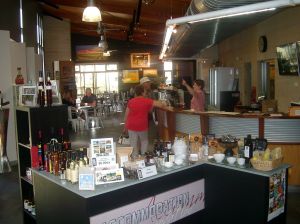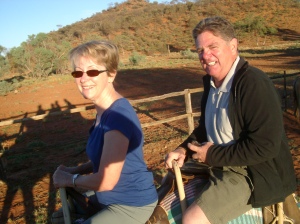Rise and shine! To wake us at 5:00 a.m., Kate played her favorite selections of ‘get up and go songs’ from her I-Pad, from the Lion King “Circle of Life” to the Beatle’s “Here Comes the Sun” she had us going in the pre-dawn darkness. After breakfast we went a lookout on a mound close to our campsite for an Uluru sunrise. A bit cloudy that morn so not as dramatic, but still worth it to see the big rock materialize from the dark.
 Then we took off to Kata Tjuta (The Olgas) for a 7km trek through the “Valley of the Winds”. The Olgas are a group of large domed rock formations about 365 km (227 mi) southwest of Alice Springs, and 25 km (16 miles) from Uluru. In this vast park there are 36 of the domes, all conglomerate or sedimentary rock masses consisting of cobbles and boulders of varying rock types including granite and basalt, cemented solid over the eons by sandstone. They are some 500 million years old and the wind does blow through the paths and gaps we explored.
Then we took off to Kata Tjuta (The Olgas) for a 7km trek through the “Valley of the Winds”. The Olgas are a group of large domed rock formations about 365 km (227 mi) southwest of Alice Springs, and 25 km (16 miles) from Uluru. In this vast park there are 36 of the domes, all conglomerate or sedimentary rock masses consisting of cobbles and boulders of varying rock types including granite and basalt, cemented solid over the eons by sandstone. They are some 500 million years old and the wind does blow through the paths and gaps we explored.

Water hole at Kata Tjuta (no I am not filling up my water bottle)
As there had been recent rains we found a fair amount of seasonal flowers, grass and plant life. Kate told of how some 60,000 years ago or so the area was much more lush and mega-fauna like giant kangaroos creatures roamed the canyons before being their debated demise. Our trek took us about 7.4 km (around 4 miles) over rocks, water and crevices.
After that journey we headed back to camp, but first had a stop at a roadside cattle station that has a store and area

My make-shift fly net.
for a barbecue lunch. The flies in Australia can be fierce and very aggressive, so many folks take to buying these nets to drape over heads and hats to keep them away. Unfortunately, you do have to peel them back to eat, so a bit defeating. And at this station the flies were the most persistent we had seen to date. I had not bought a net, so instead jokingly created a temporary one to ward of the pests (see picture). The gang thought it was quite hilarious, but it did work (though a bit hot)!
Again, back on the road. Near sunset we arrived at Kings Creek Station for a relaxing hour of goodies and for a swim in the pool, then off a way back into the station to our outback bush camp. Unlike the camp the night before, which was one of many tour camps clustered in the same campground, this new camp was just for us, miles off the road. We arrived around  sunset to a dozen tents, campfire area and a kitchen/eating shed. It was rustic yet very clean and the setting stunning. Down a trail from base camp was a toilet that flushed (no ‘long drops’ as outhouses are called here) and a hot water shower that looked out into the bush.
sunset to a dozen tents, campfire area and a kitchen/eating shed. It was rustic yet very clean and the setting stunning. Down a trail from base camp was a toilet that flushed (no ‘long drops’ as outhouses are called here) and a hot water shower that looked out into the bush.
For dinner Kate cooked up here special bread and a tasty vegetable medley with kangaroo meat. Before heading to bed we sat around the fire telling stories about our lives. Found out that teal member Jim Blonde attended the real Woodstock in 1969!
As others retired to their cabin or to a swag around the camp fire, I wandered down the dirt road a few hundred yards to soak up the night. I have camped many times in my life all over the West, from the deserts of Arizona to the Cascades of Washington, yet I have never seen a night sky like I did that night. The land around the camp is flat and in the middle of a vast desert with no towns, villages or cities for hundreds of miles. All around me it was black, like I stood in a darkened closet. But there was light: above me was brilliant sky of billions of stars, more stars than I have seen before. The Milky Way was a stream of white and the Southern Cross stood proudly over her land. With no mountains or hills the stars stretched to the horizon. No aircraft flew above, only one satellite crawled by yet oddly, no shooting stars. I stood transfixed for nearly and hour, knowing this was a special place and time to remember. Later as I crawled into bed I heard dingos howling in the distance.
Kate had talked our group into getting up even earlier (4 a.m.) to head to Watarrka (Kings Canyon) for what their brochures describes as “a mind-blowing 6km walk through the towering walls, crevices and plateaus of Watarrka.” So once again, we awoke to music. As it was still pitch black I looked up at the stars. All the constellations had shifted with the earth’s rotation, but I did see two shooting stars this time.
We arrived in the dark, the first of anyone to the car park. A strong wind blew and Kate gave us the run down of the hardest stretch of the hike, the ascending of “heart attack hill,” a scramble up a wall of natural stepping stones. But after thirty minutes she said we had finished the hardest part and I was surprised: The climb did not seem bad at all. Guess the cool weather helped.

The Ampitheatre at Kings Canyon
For our early morning sacrifice we were rewarded with predawn light and no people as we continued along the rim of the canyon. As the sun crested the horizon the colors of the canyon came to life. We stopped at the ‘Amphitheatre’ at sunrise (a bowl-like area of the canyon with sheer cliffs), and then headed to the tranquil ‘Garden of Eden’. We descended a set of wooden stairs into the canyon to where water, Eucaplyptus, palms and shrubs resided on the cool canyon floor.

The peaceful Garden of Eden in the Kings Canyon.
After a snack break and contemplative time in the garden, we descended another set of stairs and were soon walking through the ‘Lost City’ , which are beehive like mounds of layered sandstone rock that dot the South flank of the canyon walk. After that, a series of descending rock steps lead the troupe back to our van. By now it was about 10 a.m. The trip had taken a little over 3.5 hours and we all agreed it was spectacular.
We journeyed back to Alice Springs mainly along dirt roads. Along the way we stopped at an overlook of a meteorite created mountain (sorry, forgot the name) for lunch. We arrived back by late afternoon and sadly separated from Kate and our new friends on the tour.
It was an amazing three days full of adventure, friendship and fun. On behalf of the group we thank Rotary District 9500 and the Peter Sutton Memorial Safari Trust for this life enriching experience. If you visit Australia, Uluru, Kata Tjuga and Kings Canyon are a must see adventure.
John
 we’d share a few clips about our adventure to Australia for Rotary International. Here are two nice stories from our local publications.
we’d share a few clips about our adventure to Australia for Rotary International. Here are two nice stories from our local publications.
 Our Rotary Vocational Training Trip to Australia was featured at the Annual Meeting of
Our Rotary Vocational Training Trip to Australia was featured at the Annual Meeting of 













 Then we took off to Kata Tjuta (The Olgas) for a 7km trek through the “Valley of the Winds”. The Olgas are a group of large domed rock formations about 365 km (227 mi) southwest of Alice Springs, and 25 km (16 miles) from Uluru. In this vast park there are 36 of the domes, all conglomerate or sedimentary rock masses consisting of cobbles and boulders of varying rock types including granite and basalt, cemented solid over the eons by sandstone. They are some 500 million years old and the wind does blow through the paths and gaps we explored.
Then we took off to Kata Tjuta (The Olgas) for a 7km trek through the “Valley of the Winds”. The Olgas are a group of large domed rock formations about 365 km (227 mi) southwest of Alice Springs, and 25 km (16 miles) from Uluru. In this vast park there are 36 of the domes, all conglomerate or sedimentary rock masses consisting of cobbles and boulders of varying rock types including granite and basalt, cemented solid over the eons by sandstone. They are some 500 million years old and the wind does blow through the paths and gaps we explored.

 sunset to a dozen tents, campfire area and a kitchen/eating shed. It was rustic yet very clean and the setting stunning. Down a trail from base camp was a toilet that flushed (no ‘long drops’ as outhouses are called here) and a hot water shower that looked out into the bush.
sunset to a dozen tents, campfire area and a kitchen/eating shed. It was rustic yet very clean and the setting stunning. Down a trail from base camp was a toilet that flushed (no ‘long drops’ as outhouses are called here) and a hot water shower that looked out into the bush.










 Yes, here in the searing heat of Alice Springs you can grow grapes: All it takes is water and the right care. As Richie pointed out, the red like clay/sandy soil can be quite productive, as evidenced by the healthy vines plus the other crops he grows including experimental plots of yams and peanuts. He also has a good amount of clover in production and had been cutting it when we arrived. Luckily he has invested in a well that is tapped into a regional
Yes, here in the searing heat of Alice Springs you can grow grapes: All it takes is water and the right care. As Richie pointed out, the red like clay/sandy soil can be quite productive, as evidenced by the healthy vines plus the other crops he grows including experimental plots of yams and peanuts. He also has a good amount of clover in production and had been cutting it when we arrived. Luckily he has invested in a well that is tapped into a regional 
